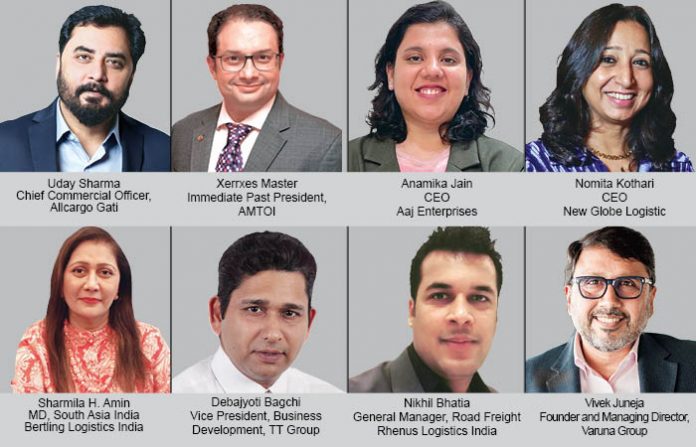India relies on network of road and rail transportation to facilitate cargo movement. Road transport handles nearly 60% of cargo, while rail carries 32%. Transporters and LSPs face difficulty when it comes to moving cargo via roads, stemming as it is from India’s geography and operational complexities, said experts.
Ritika Arora Bhola
Indian logistics industry has evolved immensely in the past few years, remarkable developments in road and rail infrastructure have made, especially after the pandemic. DFCs, economic corridors, NHs, logistics parks have streamlined the cargo operations and improved connectivity for faster deliveries. Tech-integration such as GPS, FASTag, Road Transport and Highways Development Scheme and upskilling of drivers have also played a commendable role in improving road transportation.
The Union government has launched several ambitious schemes and projects to facilitate cargo movement:
Bharatmala Pariyojana: Launched in 2017, it is a flagship programme aimed at enhancing road infrastructure across the country.
Border and Coastal Roads: It improves road connectivity to border areas and coastal regions to bolster strategic and economic interests. Focus is on developing 34,800 km of roadways. Integration with multimodal transport systems for better diverse cargo movement emphasis on reducing bottlenecks and improving road safety.
National Highways Authority of India initiatives: The NHAI plays a crucial role in development, maintenance, and management of NHs. e-Highway Projects for implementation of smart highway projects incorporating digital technologies for better traffic management and safety. Toll collection improvements for adoption of FASTag reduce congestion at toll plazas and ensure seamless cargo movement. RTHDS focuses on improving road transport infrastructure and includes various projects and reforms. Upgrading existing roads comprises widening and strengthening of roads to handle higher traffic volumes. Improvement in road safety measures to enhance road safety through better signage, road markings, and enforcement of traffic rules.
National Logistics Policy integrates multimodal transport facilitates seamless movement of goods through integrated road, rail, and waterways. Reduction of logistics costs streamlines processes to reduce logistics costs and improve competitiveness.
Pradhan Mantri Gram Sadak Yojana focuses on improving rural connectivity. The yojana aims to connect rural areas with highways and market centers. Enhanced rural access gives better road connectivity in rural areas to facilitate the movement of agricultural produce and goods. Economic development boosts rural economies by improving access to markets and services.
Green National Highways Corridor Project, funded by the World Bank, aims to make road infrastructure environmentally friendly. Sustainable Road Development: Incorporating green technologies and practices in road construction and maintenance. Reducing Environmental Impact: Measures to mitigate the environmental impact of road projects, including pollution control and green cover. Infrastructure Development Funds: The government has established various funds and schemes to support road infrastructure development.
National Investment and Infrastructure Fund: It focuses on investing in infrastructure projects, including roadways.
State-Level Infrastructure Funds: Several states have their own funds and schemes for road development.
Despite improvements, road infrastructure is often inadequate, with issues such as potholes, poor maintenance, and congestion affecting efficiency. Multiple state regulations and checkpoints lead to delays and inefficiencies, impacting the overall logistics chain. Environmental concerns such as heavy reliance on diesel trucks contribute to pollution and environmental degradation. Recognising the critical role of efficient cargo transportation in driving economic growth, the government has launched several initiatives aimed at improving road infrastructure and logistics.
CARGOTALK discusses with industry professionals the crucial pain points in road transportation that hinder growth and reduce logistics efficiency.
Tracking systems improve supply chain visibility
Uday Sharma, Chief Commercial Officer, Allcargo Gati
Road transport faces pain points such as poor infrastructure, frequent checkpoints, and heavy congestion. Complex documentation, regional regulations, and tax burdens drive up compliance costs and increase operational expenses. Rising fuel prices, cargo theft, and limited real-time tracking reduce efficiency. Digitalisation can streamline operations with real-time tracking systems, improve supply chain visibility and reduce inefficiencies. Transitioning to alternate fuel vehicles and fuel-efficient technologies can lower operational costs. To optimise freight movement, shifting cargo to rail is essential, and in this regard, projects such as the DFCs will play a vital role.”
Poor route planning, fuel theft still ail sector
Xerrxes Master, Immediate Past President, AMTOI
Some of the challenges include uneven roads, congestion in urban areas, regulatory and compliance issues, multiple permits and taxes, overloaded regulations. On top of corruption issue at check points, there is fuel cost, its volatility and fluctuations, fuel theft & pilferage, cargo damage & theft, risk of theft, especially of high-value goods, damage to goods, inadequate insurance coverage, limited technology adoption, lack of visibility to most transporters. To overcome the issue of shortage of skilled drivers & retention wor king conditions of have to be improved. Inefficient route planning leads to inordinate delays at checkpoints and time-consuming border crossings.”
Infrastructure to get more private, foreign investment
Anamika Jain, CEO, Aaj Enterprises
A significant shortage of qualified drivers and warehouse and operational staff impact overall efficiency and productivity. EVs and usage of part truckload service vehicle, implementating route optimisation for managing fuel consumption and control costs. AI-based climate models with real-time data to forecast extreme weather conditions and mitigate threats to supply chain must be leveraged. Improving recruitment efforts by offering competitive salaries, providing training programmes, and enhancing working conditions to boost overall efficiency and productivity. With commitments to reduce CO2 footprint, the sector will see increased usage of EVs and renewable energy in ports.”
ULIP frees transport sector, exporters of bulky processes
Nomita Kothari, CEO, New Globe Logistic
Though many initiatives have been taken by the government, the execution should be measured, and processes followed diligently. Digital integration system will lead to seamless and faster workflow, making logistics more efficient. ULIP aims to collapse all logistics and transport sector digital services into a single portal, freeing exporters from heavy processes. Ease of Logistics Services (ELS) will allow the industry to take up operational issues with government agencies for speedy resolution. Comprehensive Logistics Action Plan comprises integrated digital logistics systems, benchmarking service standards and capacity building among others.”
Quality roads, intermodal hubs smoothen cargo flow
Sharmila H. Amin, Managing Director, South Asia India Bertling Logistics India
The sector faces many challenges that hinder smooth cargo movement. Transporters and logistics service providers deal with varying cargo types, each requiring different handling, transportation conditions, and vehicle types. Managing these differences, while ensuring timely delivery, is a crucial pain point. Traffic congestion, inadequate infrastructure, and lack of real-time visibility exacerbate operational inefficiencies. Compliance with fluctuating regulations across states, increase costs and operational complexity. Collaboration between LSPs and shippers promote shared resources, improve asset utilisation and reduce empty miles.”
PMGS helps in slashing problems in supply chain
Debajyoti Bagchi, Vice President, Business Development, TT Group
The government’s focus on Bharatmala aims to improve the national corridor, including Golden Quadrilateral North-South, East-West corridors. Another focus area could be creating a green corridor between Chennai-Hyderabad-Bengaluru-Chennai and Ahmedabad-Mumbai-Ahmedabad by road. Another DFC that can be mentioned is Delhi-Mumbai Industrial Corridor that facilitates faster, reliable cargo movement. PMGS is a multimodal linkage aimed to bridge infra gaps and offer integrated logistics solutions that align with road, rail, air, and waterways. It helps in cutting reducing bottlenecks in the supply chain.
Lack of infra makes smooth cargo flow difficult
Nikhil Bhatia, General Manager, Road Freight, Rhenus Logistics
India During monsoon, cargo movement becomes quite challenging. With drivers lacking training and know-how to handle specialised cargo, it often leads to safety risks, product damage, and delays. They must be given better working conditions, fair wages, safety, and sufficient rest periods, which can also put the drivers’ shortage issue to rest. In Canada and Europe, drivers enjoy financial stability and a status in the society. The sector must hurry to adopt sustainable energy resources such as CNG and EVs to help mitigate rising fuel costs. Reducing CO2 emissions and attaining cost efficiency is possible by adopting EVs for which the government is giving subsidies.”
Absence of visibility during transit is major concern
Vivek Juneja, Founder and Managing Director, Varuna Group
Managing diverse cargo to oversized shipments necessitates specialised handling, which frequently leads to complex operations and increased costs. The absence of real-time visibility during transit is another concern for logistics service providers. Contributing to these are these inefficiencies are vehicle breakdowns, route deviations, harsh weather conditions and suboptimal driver behaviour. The seasonal demand makes vehicle availability and resource management difficult, forcing LSPs to manage peak periods sans compromising quality. Addressing these pain points requires technological solutions, such as real-time tracking and optimised fleet management among others.”













